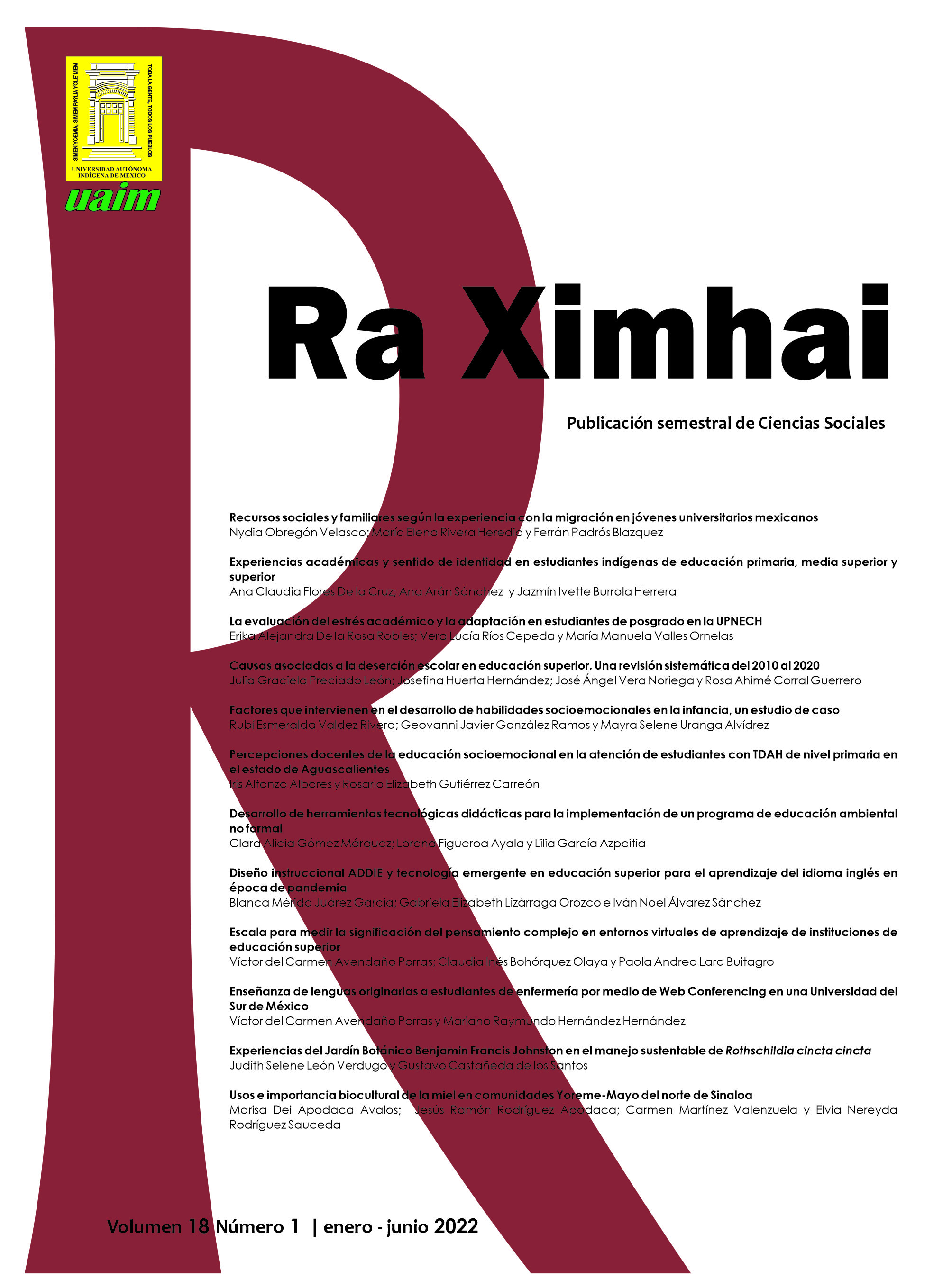Teachers' perceptions of socio-emotional education in the care of students with ADHD at the primary level in the state of Aguascalientes
DOI:
https://doi.org/10.35197/rx.18.01.2022.06.iaKeywords:
perception, teacher, socioemotional education, ADHDAbstract
Attention deficit hyperactivity disorder (ADHD) becomes more prevalent in boys and girls in Basic Education. The World Health Organization (WHO) reports that there is a prevalence of attention deficit hyperactivity disorder (ADHD) of five percent, and in the case of Mexico, without having a precise figure, it is estimated that it affects one and a half million boys and girls under the age of 14. (UNAM, 2020, para. 1).
ADHD has a growing population of children; students with ADHD have difficulties expressing their emotions and acting in a self-regulated manner in daily interactions with their peers, teachers and with their family, some actions undertaken at school or family complicate the behavior of boys and girls (NN) , excluding them from activities, labeling them as problem students and suffering the rejection of their own peers, causing childhood depression and discouragement from attending school, the above harms their socio-emotional education "these children are frequently classified as rude, making the child responsible and /or their relatives of their behavior as something voluntary and perfectly avoidable” (De Burgos, sf para.3). The perceptions of NN with ADHD are often not the most favorable to contribute to a Socioemotional Education that helps them exercise their right to education in harmony, respect for integrity and, above all, enjoy the moments significant learning that favors you to comply with the principles of the New Mexican School (NEM).
The president of the article shares the perceptions that teachers have in the area of Socioemotional Education, with a proposal that aims to link attention to students with ADHD and meaningful learning as a pedagogical approach to the current curriculum. Returning to Socioemotional Education as a core area for all children, in particular for students with ADHD.
The study shown below is a qualitative research framed under the phenomenological paradigm, it wants to understand social phenomena from the actor's own perspective. It examines the way the world is experienced. The reality that matters is what people perceive as important. (Taylor and Bogdan, 1987)
Downloads
References
Alvarez-Gayou, J. L. (2003). Cómo hacer investigación cualitativa. Fundamentos y metodología. Paidós: México
De Burgos, R. (2020, 20 de mayo). Emociones en el TDAH: conoce su importancia. https://www.tdahytu.es/2020/05/29/las-emociones-en-el-tdah/
Franquiz Santana. F., Ramos Martínez, S. (2016). TDAH: Revisión teórica del concepto, diagnóstico, evaluación y tratamiento. San Cristobal: ULL.
García T., (s.f.). Habilidades sociales en niños y adolescentes con TDAH. Consultado el 28 de julio del 2021. https://www.ampachico.es/habilidades-sociales-de-los-ninos-y-adolescentes-con-tdah/
Godoy Lenz, P. (2009). Déficit atencional. Guía para su comprensión y desarrollo de estrategias de apoyo, desde un enfoque inclusivo, en el nivel de educación básica. https://especial.mineduc.cl/wp-content/uploads/sites/31/2016/08/201305151612430.Deficit_Atencional.pdf
IMSS. (2020). Durante confinamiento, fundamental que menores con TDHA realicen actividades en casa y sean constantes con sus medicamentos. http://www.imss.gob.mx/prensa/archivo/202007/473
Meca R., (2012). Dificultades en las habilidades sociales en niños con TDAH. Consultado el 25 de julio del 2021. https://www.fundacioncadah.org/web/articulo/dificultades-en-las-habilidades-sociales-en-ninos-con-tdah.html
Mena Pujon, B., Nicolau Palou, R., Salat Foix, L., Tort Almeida, P., Romeo Roca, B. (2006). Guía práctica para educadores. El alumno con TDAH. Barcelona:Mayo.
Perote Alejandre, A., Serrano Agudo, R. (2019). TDAH: Origen y Desarrollo. Madrid: Instituto Tomás Pascual.
Russi E. (2020). Trastornos de aprendizaje en el TDAH. https://www.tdahytu.es/2020/05/29/trastornos-del-aprendizaje-en-el-tdah/
SEP. (s.f.). Orientaciones para Elaborar el Programa Escolar de Mejora Continua. SEP. http://edu.jalisco.gob.mx/consejo-tecnico-escolar/sites/edu.jalisco.gob.mx.consejo-tecnico escolar/files/orientaciones_pemc.pdf
SEP. (2017). Estrategia de equidad e inclusión en educación básica: para alumnos con discapacidad, aptitudes sobresalientes y dificultades severas de aprendizaje, conducta o comunicación. México: SEP
SEP. (2017). Plan y programas de estudio. Consultado el 1 de agosto del 2021. https://www.planyprogramasdestudio.sep.gob.mx/index-prog-estudio-btn.html
UNAM. (2020). TDAH afecta a más de un millón y medio de niños mexicanos. https://www.fundacionunam.org.mx/unam-al-dia/trastorno-de-deficit-de-atencion-e-hiperactividad-afecta-a-mas-de-un-millon-y-medio-de-ninos-mexicanos/
Taylor, S. Bogdan, R. (1987). Introducción a los métodos cualitativos de investigación. España: Paídos.
Thapar A, Pine D, Leckman JF, Scott S, Snowling MJ, Taylor E. Rutter’s Child and adolescent psychiatry. Sixth Edition. New Jersey: Willey Blackwell; 2015. p. 738-756.
Downloads
Published
How to Cite
Issue
Section
License
Copyright (c) 2022 Iris Alfonzo Albores, Rosario Elizabeth Gutiérrez Carreón

This work is licensed under a Creative Commons Attribution-NonCommercial 4.0 International License.
Usted es libre de:
- Compartir — copiar y redistribuir el material en cualquier medio o formato
- Adaptar — remezclar, transformar y construir a partir del material
- La licenciante no puede revocar estas libertades en tanto usted siga los términos de la licencia
Bajo los siguientes términos:
- Atribución — Usted debe dar crédito de manera adecuada , brindar un enlace a la licencia, e indicar si se han realizado cambios . Puede hacerlo en cualquier forma razonable, pero no de forma tal que sugiera que usted o su uso tienen el apoyo de la licenciante.
- NoComercial — Usted no puede hacer uso del material con propósitos comerciales .
- No hay restricciones adicionales — No puede aplicar términos legales ni medidas tecnológicas que restrinjan legalmente a otras a hacer cualquier uso permitido por la licencia.








